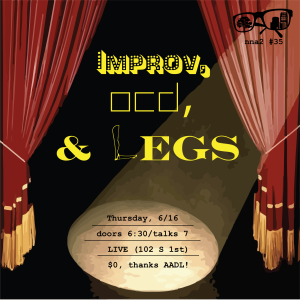We’re back! NNA2 returns from break Thursday, June 16 — mark your calendar! We’ve got a solid session featuring quick thinking, robotic legs and sticky brains! First up, Patti Smith schools us on the history of improv comedy, illuminating the ways its concepts pops up in our day-to-day lives. Shai Revzen opines on the greatness of legs, and walking us through his related research — making robot legs and mobility better and better. Capping things off, social worker Sara Tischler breaks down obsession, compulsion, OCD research, and techniques that help people “un-stick” the brain. Grab a fellow nerd, order a refreshing drink, and we’ll see you there!
When: Thursday, June 16, 2016, doors at 6:30 pm, talks at 7 pm!
Where: LIVE, 102 S First St, Ann Arbor
$$$: NO COVER! Thanks for having our back, Ann Arbor District Library!
We use improv our entire lives, even we don’t realize it. One could say that humans started doing improv when we started using the spoken language. But how did improv as art form get started? And what does it look like now? Most importantly–how and why should YOU try it? Patti Smith will talk about the history of the art form, examples of improv, and local opportunities to try it yourself.
About Patti: Patti Smith is a special education teacher and writer who lives in Ann Arbor with her husband and cats. Patti is the author of two books about history in Ann Arbor, the most recent of which is The History of Ann Arbor’s People’s Food Co-op. She loves storytelling, most forms of public speaking, especially improv! She believes that improv is for everyone!
Sara Tischler — Un-sticking your Brain: OCD and its Treatment
 Obsessions are “sticky” thoughts, images or impulses that occur over and over again and feel uncontrollable. Compulsions are repetitive behaviors or rituals that someone uses to get rid of the obsessions. Together they make up obsessive compulsive disorder, or OCD. Hear about OCD and exposure and response prevention (ERP), an evidence-based treatment for the mental health disorder that affects approximately 3.3 million people in the United States.
Obsessions are “sticky” thoughts, images or impulses that occur over and over again and feel uncontrollable. Compulsions are repetitive behaviors or rituals that someone uses to get rid of the obsessions. Together they make up obsessive compulsive disorder, or OCD. Hear about OCD and exposure and response prevention (ERP), an evidence-based treatment for the mental health disorder that affects approximately 3.3 million people in the United States.About Sara: Sara is a clinical social worker in the department of outpatient psychiatry at the University of Michigan Health System. She has a Bachelor’s degree in psychology from Michigan State University (Go Green! Sorry, Ann Arbor) and a Master’s in Social Work from the University of Michigan. She completed her internship and fellowship at the University of Michigan Child and Adolescent Outpatient Psychiatry clinic, where she is now a staff social worker. She provides psychotherapy for children of all ages and their families. Besides OCD, her clinical interests include anxiety disorders, autism spectrum disorder, depression, and trauma/grief. She was born and raised in Southeast Michigan and lives with her partner, Alex. Together they have two beautiful (furry) “children” — Phoebe the dog and Bu the cat, whom she talks about constantly.
No animals other than ourselves move on wheels. That might seems strange, given how efficient and effective wheels are for moving around on land. Nevertheless, there are many good reasons to love legs. These include more obvious reasons, like the ability to use sparse footholds on rough surfaces, and less obvious reasons, such as newly discovered ways that legs make it easier for animals to control their movements. Insights from the animal world are leading to new and amazingly capable walking and running robots.
About Shai: Shai Revzen is an Assistant Professor in the Electrical Engineering and Computer Science Department and in the Ecology and Evolutionary Biology Department of the University of Michigan, and heads the BIRDS Lab. This confusion about where he belongs isn’t new — he is a bit of many things that don’t seem to fit together neatly in a box. His research focuses on the biomechanics of organisms, the legged locomotion of robots, and the mathematical tools that connect the two. Before becoming an academic by running cockroaches on treadmills for six years at the University of California at Berkeley, he worked as a Chief Architect in mid-sized company in Silicon Valley, went around the world, and was unabashedly nerdy.


